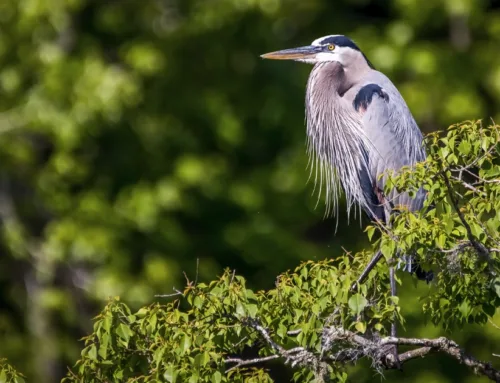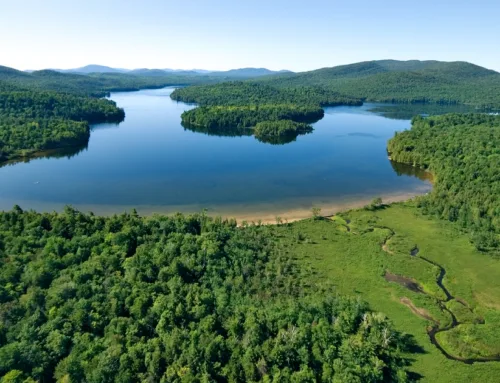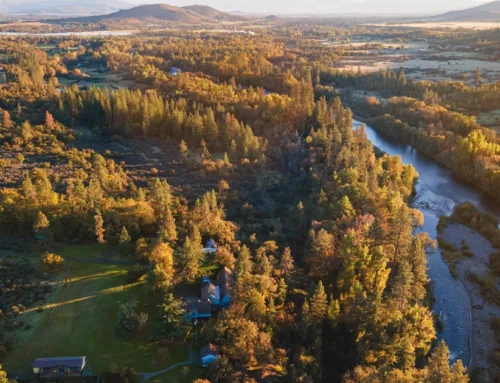Bearing the Brunt
Bearing the Brunt
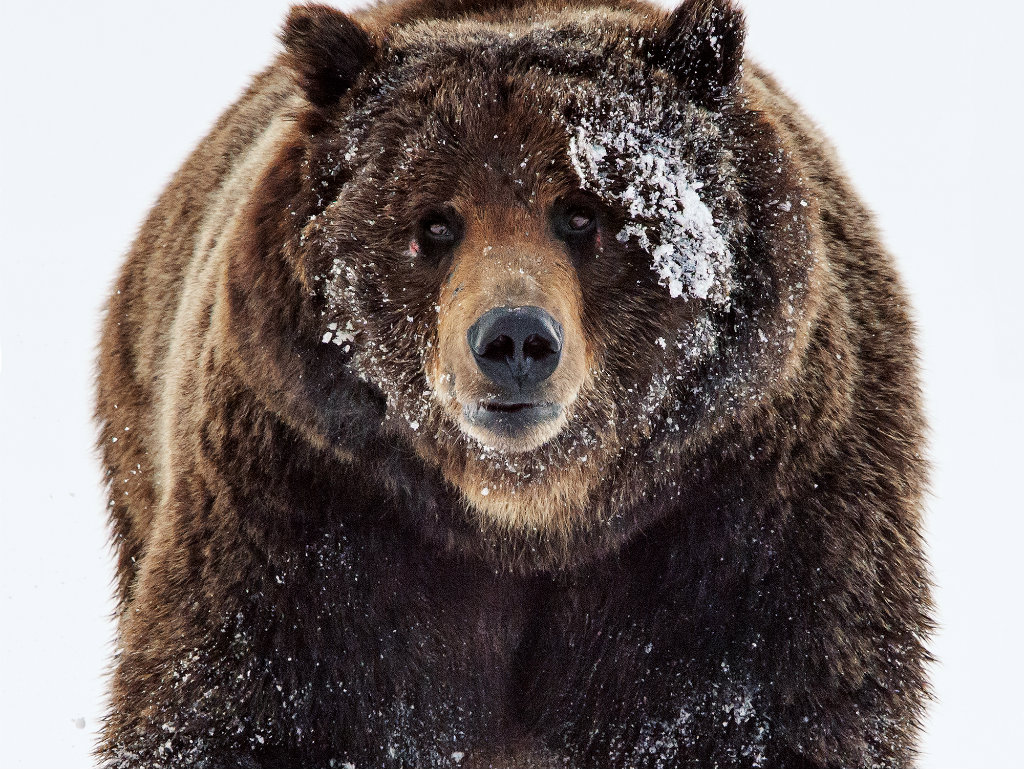
MountainOutlaw01_fi
The Ninth Circuit Court of Appeals recently affirmed a lower court ruling that maintains federal protection for grizzly bears in the 22.5-million acre Greater Yellowstone Ecosystem.
BY TODD WILKINSON | PHOTOGRAPHY BY THOMAS MANGELSEN
The recovery of grizzlies in the Greater Yellowstone Ecosystem ranks as one of the most resounding success stories in the history of wildlife conservation. In the early 19th century, an estimated 50,000 grizzlies roamed the American West. By the early 1970s, they had vanished from 98 percent of their historic range. By then, no remnant population was more famous than the bears of Yellowstone National Park. In 1975, concern that they might become extinct prompted the federal government to extend emergency protections to four distinct populations under the Endangered Species Act. Yet the Yellowstone population dwindled even further. At its nadir, only 136 bears remained.
Hunting seasons were curtailed. Poachers faced heavy fines and even prison time. Mining and drilling deemed harmful to habitat ceased. Drastic measures were taken to reduce conflicts between bears and people. Locals were taught how to prevent the beasts from foraging through trash bins for food.
Chris Servheen, who presided over grizzly recovery for the US Fish and Wildlife Service (USFWS) for more than 30 years, told me that he honestly thought grizzly bears might vanish. Yet before he retired in 2016, the Greater Yellowstone population had rebounded to more than 700. Today, grizzlies in the Greater Yellowstone Ecosystem and those in the massive Northern Continental Divide Ecosystem farther north are showing up in old haunts where they haven’t been seen in more than a century.
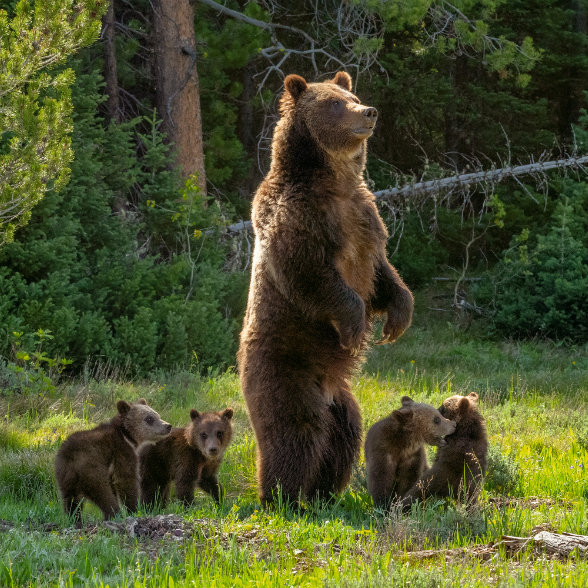
SUPER MOM | Known to researchers as Grizzly 399, this 24-year-old sow is a stellar matriarch. Earlier this year, she emerged from her den with four cubs.
A star attraction is Jackson Hole Grizzly 399, the name bestowed by researchers upon a singular sow. The 24-year-old has given birth to numerous cubs. In 2020, she created an international sensation when she emerged from her winter lair with an astonishing brood of four. (Twins are the norm. Triplets are less common. A quartet? An extremely difficult task for any mother.)
As long as the bruins are pursuing wildlife and not cattle and sheep on private property, the acclaim and the attention are positively exciting for neighboring ranchers, too. But grizzlies know no boundaries. They are drawn to cattle pastures and hay fields. Just ask Shannun Rammel. In July, he stumbled upon a grizzly sleeping in an abandoned shed on his property outside Choteau. Thanks to some quick thinking by his wife — she jumped behind the wheel of their truck and startled the bear by gunning the rig directly at it — somehow the Northern Montanan survived. Barely. Bitten and bleeding, the 50-year-old had to be hospitalized.
“I believed bears should have been delisted years ago,” Dan Vermillion says. A Livingston-based fly-fishing guide who owns Sweetwater Travel Company with his two brothers, Vermillion recently stepped down after 12 years of service on the Montana Fish, Wildlife & Parks Commission, which he also chaired. His profession and public service give him exceptional insight on grizzlies. “They can be dangerous animals. We don’t want to see them in the apple orchard or getting into the granary or ending up in the backyard walking by the swing sets where kids play. But that’s happening, and it would cause anyone concern,” the native Montanan says.
Legendary primatologist Dr. Jane Goodall counters. Goodall has made several trips to Greater Yellowstone to view grizzlies. “I find the prospect of sport hunting grizzlies again to be appalling. We shouldn’t recover a highly intelligent animal so that it can be turned into a floor rug or its head gawked at as a prize on the wall,” she told me.
Matt Hogan, a senior official with USFWS who serves on a special grizzly bear management committee in the Lower 48, said that it is not his agency’s prerogative to instruct the states on what to do. Yet he is sympathetic to the profound attachment many Americans have for grizzlies.
Hogan, who previously served as government affairs manager for Safari Club International, believes grizzlies can and should be responsibly hunted. He is quick to point out that should the Greater Yellowstone grizzly population ever fall below minimal levels, the bear can be relisted and control can be wrested away from the states again.
Paul Gilroy, a Safari Club member who lives near Grand Teton National Park, sees a commercial opportunity for his business. During an interview with the Jackson Hole News & Guide, the Wyoming outfitter told Mike Koshmrl that the sale of hunting tags for a few select opportunities to hunt grizzlies could raise money for state wildlife agencies. “It would be a very popular hunt, easily advertised and easily booked. We have some very large bears here, which would make for commendable trophies,” Gilroy said.
That very scenario was halted in 2018. The year before, USFWS had removed the grizzly from the threatened species list. Sporting hunts were scheduled in Idaho and Wyoming. But a lawsuit by tribal entities and conservation groups derailed the hunting of 21 grizzlies in Wyoming just hours before it was slated to commence. US District Court Judge Dana Christensen subsequently restored Endangered Species Act protection.
Randy Newberg of Bozeman hosts the Sportsman Channel’s Fresh Tracks with Randy Newberg. In addition, he oversees one of the most popular web podcasts devoted to hunting on public lands in the nation.
Years ago, Newberg killed a grizzly in Alaska, part of a dream hunt he shared with his 82-year-old grandfather. “It was the thrill of a lifetime,” he says. But Newberg is not interested in hunting Greater Yellowstone grizzlies. Almost two decades ago, he served on a blue ribbon panel of citizens that examined whether the scientific goals used to gauge the recovery had been met. He concluded they had. Newberg supported the move to remove grizzlies from federal protection in 2017 just as he had in 2007 when the Greater Yellowstone population was temporarily delisted. But an earlier set of lawsuits that highlighted the lack of government analysis in assessing the loss of a key food source — nuts from whitebark pine trees caused by climate change — delayed delisting for another decade.
“I’ve told people that I am in favor of hunting being made available to states as a management tool, but I’ve also said the state wildlife agencies need to proceed with extreme caution,” Newberg says. “There is a lot at stake for the credibility of the states in the public’s eye. There is a lot at stake for the reputation of hunting. And, most importantly, there is a lot at stake for the grizzly.”
Newberg ponders where hunts should take place: on the outlying edges of the ecosystem or closer to parks with higher concentrations of bears and people and conflict. The states have said they first intend to target problem bears, bruins that prey on livestock, wander into communities, or become dumpster divers.
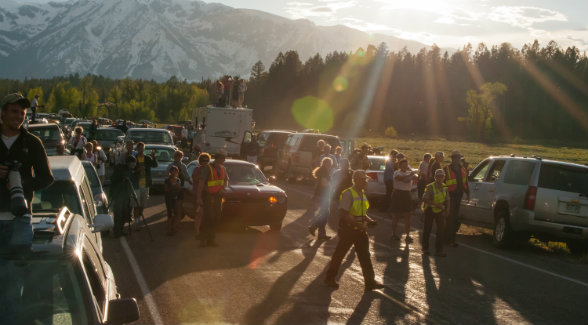
BEAR JAM | The digital era has heightened the international appeal of the grizzly. In this image, Grand Teton National Park rangers cordon off eager onlookers.
USFWS has gone back to the drawing board and is working closely with the State of Montana on next steps. Simultaneously, state wildlife officials are coordinating with private landowners to establish a land bridge between the Greater Yellowstone population and the Northern Continental Divide population.
One of the key corridors is the Gravelly Mountains, a mix of public lands and private ranchlands in Southwest Montana. After grizzly predation on cattle owned by ranchers began to increase, the Western Landowners Alliance convened a gathering of landowners, agency personnel, and conservation-based nonprofits to improve the compatibility between healthy grizzly populations and healthy ranching communities in
November 2019.
I was one of the 100-plus in attendance at the Alder Fire Hall. Many ranchers in attendance vented their frustrations.
“We thought the world would end when wolves were brought back. That didn’t happen, but grizzlies bring much bigger challenges,” one said. Rancher and state legislator Albert Sommers noted a substantial uptick in losses endured by many of his constituents, family-owned ranches. “The Upper Green River Cattle Association has seen its calf loss rates go from 2 percent in the early 1990s to 10 to 15 percent in recent years,” Sommers said.
Sommers represents Sublette County in the Wyoming House of Representatives. All four of his grandparents homesteaded in the Green River Valley. He champions incentives aimed at making grizzlies and wolves less of a financial burden to landowners. He knows they are here to stay. He wishes he could make the same guarantee about ranchers who face many different threats to their survival.
“Compensation is the key to keeping ranchers on the landscape, even when wildlife managers and policymakers change bear management and philosophies,” Sommers says.
“Regardless of the grizzly’s legal status, private land will also figure prominently in the cause of American conservation and the future of the bear,” says Roger Lang, former owner of the Sun Ranch in the Madison Valley of Montana.
“If there’s an enemy, and I don’t like to divide the world up that way, it is subdivision,” Lang says. “It permanently takes habitat off the table. We need to all be allies in the cause of protecting the open space grizzlies need to persist, because that same habitat is important to elk and pronghorn, and keeping individual people on the land, and continuing family traditions. We are in this together. I consider the recovery that has occurred with grizzlies to be a miracle, and we all made it happen.”
To its credit, the Western Landowners Alliance subsequently researched and published Reducing Conflict with Grizzly Bears, Wolves and Elk: A Western Landowners’ Guide. And a special citizens committee is drafting a plan that will guide state grizzly management after delisting happens.
“Keeping ranching economically viable is the best way to keep wildlife habitats connected and available for wildlife,” Sommers insists in Reducing Conflict. “Working ranches are better places for big wildlife species than housing developments.”


